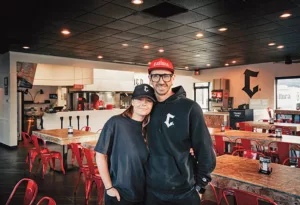
Home » Transportation council will seek $50 million for projects
Transportation council will seek $50 million for projects
SmartRoutes effort will promote pedestrian-bike funding
February 26, 1997
The Spokane Regional Transportation Council says it will seek up to $50 million in grant money for transportation projects aimed at getting more people to walk or ride a bike rather than drive a vehicle.
Eve Nelson, a senior transportation planner with the council, says the agency is working with the Spokane Regional Health District, in an effort the two call SmartRoutes, to seek funds for such projects. The council recently selected Alta Planning + Design, of Portland, to help it prepare a presentation it will use to seek grants for the projects, Nelson says.
One major possible source of such grant money is a federal transportation program thats slated to end next year. Congress is expected to consider reauthorizing it, perhaps as soon as 2010, which could mean that as much as $2 billion might become available for non-motorized transportation projects nationwide.
In 2005, four other communities each received $25 million in grants under the program in pilot projects. They were Sheboygan County, Wis.; Minneapolis, Minn.; Marin County, Calif.; and Columbia, Mo.
Nelson says SRTC and the health district here hope that if the program is reauthorized, there will be opportunities for 40 communities across the country to get $50 million each to advance projects that cater to non-motorized transportation. Spokane, she says, wants to be one of those communities.
Nelson says Spokane County was used as a control community when the funding program was in its pilot stages. As such, it received no project money, but did get a complete survey of its transportation usage, which Nelson says will give the SmartRoutes effort here a competitive edge when it applies for grants. The council paid about $2,000 to help pay for the survey, which was used to evaluate use of various transportation modes.
We got an incredibly good survey of our communitywhat our current levels of usage are and the impediments to the community for biking and walking. We feel it gives us a leg up, she says.
That 2006 survey showed that Spokane County measures up to the national average for use of public transportation and walking, but falls short of the national average for bicycling, Nelson says. She says one of the goals of the program is to increase the number of and access to bike trails here to boost residents use of biking as a form of alternate transportation.
The SRTC and the health district are identifying possible projects that could be done in the next six years, though funding for them hasnt been identified. We will outline what a $50 million non-motorized project would look like here, she says.
The SRTC has prioritized those projects in a list to be used in grant applications, using results from the survey to help set its evaluation criteria, Nelson says. The final project list and sample grant documents should be ready soon.
Topping the groups list of priority projects is developing a network of bicycle lanes in downtown Spokane, which already is in the citys draft six-year street plan, though it isnt funded. No cost estimate has been provided for that project, but another SmartRoutes priority thats been added to the citys six-year street plan is a $1 million project that would create so-called bicycle boulevards within the city. Such thoroughfares prioritize bicycle traffic by posting signs or marking the pavement to indicate heavy bicycle traffic, and marking intersections to give rights of way to bicycle boulevard users.
Another high-ranking priority would be construction of an urban bike-pedestrian trail between Millwood and Spokane Valley, Nelson says. It would run between Fancher Way near Utah Street and the Mirabeau area.
Nelson says a trail on the rivers south side would encourage non-motorized commuting there, because there currently are few places for travelers to cross the river to access the Centennial Trail.
If you have to go out of direction to cross the river, a commuter isnt likely to do that, she says.
Another project the council considers a priority is connecting the Ben Burr Trail in the East Central neighborhood to the Centennial Trail, Nelson says.
These all come from plans that have been in development, Nelson says. We are trying to find a way to fund these and looking at the ones that would get people walking or biking as quickly as possible.
Nelson says that if the SRTC ultimately does receive a $50 million grant, it estimates that between $30 million and $40 million would be allocated for planning and construction, and the remaining $10 million would be used for education and encouragement programs, and for evaluation of the outcomes of the projects funded by the grant.
She says the SmartRoutes document also will be used to pursue money from other sources.
Contact Jeanne Gustafson at (509) 344-1264 or via e-mail at [email protected].
Latest News
Related Articles



_web.webp?t=1764835652)